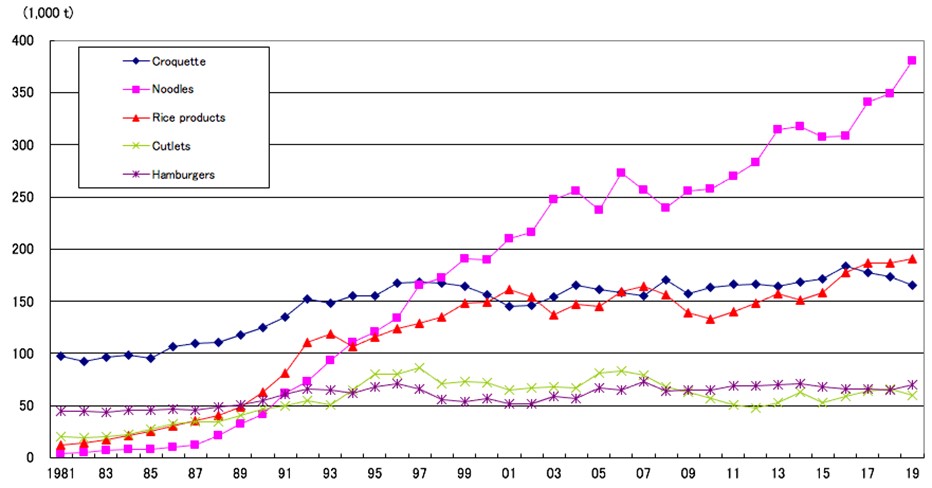Nowadays, frozen food has become an indispensable food. The graph of the Mordor Intelligence shows that frozen foods have spread over a wide area, except for the African and South American continents (Frozen Food Market (2021 – 2026) | Size, Share, Growth, 2021).
In addition, Europe has the biggest share of frozen foods in the world today. Japan maintains a high level of quality and technology for frozen foods. In this journal, the frozen foods in Japan and Europe will be compared.

History and Types of Frozen Foods
The moment that the real birth of frozen food was considered was on March 6, 1930. The first frozen food case was installed in a retail store in Springfield, Massachusetts, USA, by the General Foods Company.
Japan
Japan started the first refrigeration business in Japan in 1920. Japan’s home-use frozen food market had been growing rapidly since the late 1960s. However, the quality of commercially frozen foods during this period was not high enough to gain the consumers’ trust. Since then, frozen foods have expanded in line with environmental changes, such as the shift to nuclear families in Japan, the spread of microwave ovens, the growth of major retail chains, and the development of frozen logistics networks.
Europe
Frozen foods were initially a force in North America and later gradually spread to Europe. Among the Europeans, Germany was the first country to show frozen foods at the Anuga, which stands for Allgemeine Nahrungs- und Genussmittel-Ausstellung (Anuga) in Cologne in 1955. Anuga is the world’s biggest and most important food and beverage fair. At that Anuga, six representatives from Germany who were innovators in frozen foods introduced their first products in package sizes suitable for home consumption. Subsequently, as German families’ appliance technology steadily increased, the demand for frozen foods also grew.
Trends in Frozen Foods
Japan
According to the date of the一般社団法人 日本冷凍食品協会 (Japan Frozen Food Association), 1,551,213 tons of frozen food will be consumed annually in Japan in 2020(品目別国内生産量推移 | 一般社団法人 日本冷凍食品協会, 2021). Moreover, the Japan Frozen Food Association shows that the Japanese are very fond of prepared frozen foods, mainly noodles, croquettes, hamburgers, and baked rice (STATISTICS OF FROZEN FOOD IN JAPAN | 一般社団法人 日本冷凍食品協会, 2021). In Japan, frozen food is partly used for daily meals and lunch boxes to save time. Frozen foods are, so to speak, the ally of single people and housewives.

Europe
Germany, France, and the UK are three of the most important frozen food markets in Europe. The Russell Publishing Ltd. article states that Germany accounted for the largest share of 23.5% of the European frozen food market in 2017 (Rajput and Manepalli, 2021).
Furthermore, the CBI estimates that European consumption of frozen food amounted to 4.7 million tonnes in 2018 (The European market potential for frozen vegetables | CBI, 2021).
The most popular frozen foods in Europe have frozen prepared foods. This is followed by seafood, meat, vegetables, and fruits. The demand for frozen food in Europe is increasing because it takes less time to process or cook, and it is also becoming more popular among the expanding number of female workers. Additionally, as the percentage of vegans has risen in recent years, the consumption of fruits and vegetables has gone up.
Future of Frozen Foods
Japan
While the declining population and ageing population are seen as a problem in Japan, the demand for frozen foods is expected to remain firm as the number of dual-income, single-income, and elderly households increases. In addition, Sustainable Development Goals or SDGs have recently been advocated in Japan, and leading Japanese companies, such as Ajinomoto Company, aim to create sustainable products. However, as the domestic frozen food market will inevitably shrink, frozen food companies are pinning their hopes on overseas markets.
Europe
Europe will continue to expand its share of the frozen food market. Europe is trying to improve sales of frozen foods by making them premium with better quality ingredients and differences compared to other products. In addition, Europe is focusing on own-brand products instead of mainstream brands. By doing so, own-brand products are relatively lower priced and strive to increase the purchasing power of the target audience who want to save their household budget.
Conclusion
In both Japan and Europe, where frozen foods are particularly well developed, precooked frozen foods are particularly preferred. As Japan’s population is expected to decline in the future, the company is expected to develop products that incorporate the SDGs while targeting products for overseas markets.
Europe aims to further expand its frozen food business by focusing on premium products and its own brand.
Reference
- Cbi.eu. 2021. The European market potential for frozen vegetables | CBI. [online] Available at: <https://www.cbi.eu/market-information/processed-fruit-vegetables-edible-nuts/frozen-vegetables/market-potential> [Accessed 2 November 2021].
- Mordorintelligence.com. 2021. Frozen Food Market (2021 – 2026) | Size, Share, Growth. [online] Available at: <https://www.mordorintelligence.com/industry-reports/frozen-food-market> [Accessed 2 November 2021].
- Rajput, M. and Manepalli, N., 2021. Russell Publishing Ltd.. [online] NEW Food. Available at: <https://www.newfoodmagazine.com/article/85261/exotic-non-seasonal-fruit-veg-frozen-food/> [Accessed 2 November 2021].
- 一般社団法人 日本冷凍食品協会. 2021. STATISTICS OF FROZEN FOOD IN JAPAN | 一般社団法人 日本冷凍食品協会. [online] Available at: <https://www.reishokukyo.or.jp/statistic/statics-eng/> [Accessed 2 November 2021].
- 一般社団法人 日本冷凍食品協会. 2021. 品目別国内生産量推移 | 一般社団法人 日本冷凍食品協会. [online] Available at: <https://www.reishokukyo.or.jp/statistic/quantity-item/> [Accessed 2 November 2021].
